Investigating the Impacts of the Political System Components in Iran on the Existing Water Bankruptcy
Abstract
:1. Introduction
2. Biophysical and Sociopolitical Context
2.1. Water Resources and Climatological Potentials and Challenges in Iran
2.2. The Existing Political Structure
3. Necessity of Democracy for Sustainable Management of Water Resources
3.1. Importance of Public Involvement and Democracy
3.2. Democracy, Water Resources, and Developing Countries Such as Iran
4. Decentralization for the Proper Management of Water Resources
Formation of Committees for Restoring Water Resources
5. Conflicts of Interest between Several Governmental Sectors
6. The Impacts of Ideological Policies in Domestic and Foreign Affairs on Water Resources Management
6.1. Population Growth
6.2. Emphasis on Self-Sufficiency
6.3. The Importance of Foreign Policy
6.4. The Environment, and International Sanctions on the State
6.4.1. Restricting Access to Technology and Travel to Iran
6.4.2. Intergovernmental Financial Aid
6.4.3. Prioritization of the Government in Allocating Budgets
6.4.4. General Overview of International Sanctions
7. The State-Controlled, Resource-Dependent Economy
8. Characterizing the Relationship between the Political System and Water Resources Management in Iran Using the Matrix of Eisenhower
9. Final Remarks
10. Recommendation for Adaptation to the Water Bankruptcy Paradigm
Funding
Institutional Review Board Statement
Informed Consent Statement
Data Availability Statement
Acknowledgments
Conflicts of Interest
References
- Madani, K.; AghaKouchak, A.; Mirchi, A. Iran’s Socio-economic Drought: Challenges of a Water-Bankrupt Nation. Iran. Stud. 2016, 49, 997–1016. [Google Scholar] [CrossRef]
- Klein, C.A. Water Bankruptcy. Minn. Law Rev. 2012, 344, 560–624. [Google Scholar]
- Maghrebi, M.; Noori, R.; Bhattarai, R.; Mundher Yaseen, Z.; Tang, Q.; Al-Ansari, N.; Danandeh Mehr, A.; Karbassi, A.; Omidvar, J.; Farnoush, H.; et al. Iran’s Agriculture in the Anthropocene. Earth’s Future 2020, 8, e2020EF001547. [Google Scholar] [CrossRef]
- Sadegh, M.; AghaKouchak, A.; Mallakpour, I.; Huning, L.S.; Mazdiyasni, O.; Niknejad, M.; Foufoula-Georgiou, E.; Moore, F.C.; Brouwer, J.; Farid, A.; et al. Data and analysis toolbox for modeling the nexus of food, energy, and water. Sustain. Cities Soc. 2020, 61, 102281. [Google Scholar] [CrossRef]
- Amiraslani, F.; Dragovich, D. Combating desertification in Iran over the last 50 years: An overview of changing approaches. J. Environ. Manag. 2011, 92, 1–13. [Google Scholar] [CrossRef] [PubMed]
- Delavari Edalat, F.; Abdi, M.R. Water management in developing countries: The example of Iran. In International Series in Operations Research and Management Science; Springer: New York, NY, USA, 2018; Volume 258, pp. 37–53. [Google Scholar]
- Al-Saidi, M.; Dehnavi, S. Comparative scorecard assessment of urban water pricing policies-The case of Jordan and Iran. Water 2019, 11, 704. [Google Scholar] [CrossRef] [Green Version]
- Ashraf, S.; Nazemi, A.; AghaKouchak, A. Anthropogenic drought dominates groundwater depletion in Iran. Sci. Rep. 2021, 11, 9135. [Google Scholar] [CrossRef] [PubMed]
- Noori, R.; Maghrebi, M.; Mirchi, A.; Tang, Q.; Bhattarai, R.; Sadegh, M.; Noury, M.; Torabi Haghighi, A.; Kløve, B.; Madani, K. Anthropogenic depletion of Iran’s aquifers. Proc. Natl. Acad. Sci. USA 2021, 118, e2024221118. [Google Scholar] [CrossRef]
- Sharifi, A.; Mirchi, A.; Pirmoradian, R.; Mirabbasi, R.; Tourian, M.J.; Haghighi, A.T.; Madani, K. Battling Water Limits to Growth: Lessons from Water Trends in the Central Plateau of Iran. Environ. Manag. 2021, 68, 53–64. [Google Scholar] [CrossRef] [PubMed]
- Emadodin, I.; Reinsch, T.; Taube, F. Drought and Desertification in Iran. Hydrology 2019, 6, 66. [Google Scholar] [CrossRef] [Green Version]
- Pouladi, P.; Badiezadeh, S.; Pouladi, M.; Yousefi, P.; Farahmand, H.; Kalantari, Z.; Yu, D.J.; Sivapalan, M. Interconnected governance and social barriers impeding the restoration process of Lake Urmia. J. Hydrol. 2021, 598, 126489. [Google Scholar] [CrossRef]
- Abbaspour, K.C.; Faramarzi, M.; Ghasemi, S.S.; Yang, H. Assessing the impact of climate change on water resources in Iran. Water Resour. Res. 2009, 45, 10434. [Google Scholar] [CrossRef] [Green Version]
- Rahimi, J.; Malekian, A.; Khalili, A. Climate change impacts in Iran: Assessing our current knowledge. Theor. Appl. Climatol. 2018, 135, 545–564. [Google Scholar] [CrossRef]
- Ashraf, S.; AghaKouchak, A.; Nazemi, A.; Mirchi, A.; Sadegh, M.; Moftakhari, H.R.; Hassanzadeh, E.; Miao, C.Y.; Madani, K.; Mousavi Baygi, M.; et al. Compounding effects of human activities and climatic changes on surface water availability in Iran. Clim. Chang. 2019, 152, 379–391. [Google Scholar] [CrossRef]
- Ashraf Vaghefi, S.; Mousavi, S.J.; Abbaspour, K.C.; Srinivasan, R.; Yang, H. Analyses of the impact of climate change on water resources components, drought and wheat yield in semiarid regions: Karkheh River Basin in Iran. Hydrol. Process. 2014, 28, 2018–2032. [Google Scholar] [CrossRef]
- Mirzavand, M.; Bagheri, R. The water crisis in Iran: Development or destruction? World Water Policy 2020, 6, 89–97. [Google Scholar] [CrossRef]
- Madani, K. Water management in Iran: What is causing the looming crisis? J. Environ. Stud. Sci. 2014, 4, 315–328. [Google Scholar] [CrossRef]
- Ghazinoory, S.; Khosravi, M.; Nasri, S. A Systems-Based Approach to Analyze Environmental Issues: Problem-Oriented Innovation System for Water Scarcity Problem in Iran. J. Environ. Dev. 2021, 30, 291–316. [Google Scholar] [CrossRef]
- Tortajada, C. Water management in Singapore. Int. J. Water Resour. Dev. 2006, 22, 227–240. [Google Scholar] [CrossRef]
- Saatsaz, M. A Historical Investigation on Water Resources Management in Iran; Springer: Amsterdam, The Netherlands, 2020; Volume 22, ISBN 1066801800. [Google Scholar]
- Baggio, G.; Qadir, M.; Smakhtin, V. Freshwater availability status across countries for human and ecosystem needs. Sci. Total Environ. 2021, 792, 148230. [Google Scholar] [CrossRef]
- Kaboli, S.; Hekmatzadeh, A.A.; Darabi, H.; Haghighi, A.T. Variation in physical characteristics of rainfall in Iran, determined using daily rainfall concentration index and monthly rainfall percentage index. Theor. Appl. Climatol. 2021, 144, 507–520. [Google Scholar] [CrossRef]
- Tabari, H.; Hosseinzadeh Talaee, P. Analysis of trends in temperature data in arid and semi-arid regions of Iran. Glob. Planet. Chang. 2011, 79, 1–10. [Google Scholar] [CrossRef]
- Kousari, M.R.; Ahani, H.; Hendi-zadeh, R. Temporal and spatial trend detection of maximum air temperature in Iran during 1960–2005. Glob. Planet. Chang. 2013, 111, 97–110. [Google Scholar] [CrossRef]
- Sharafi, S.; Mir Karim, N. Investigating trend changes of annual mean temperature and precipitation in Iran. Arab. J. Geosci. 2020, 13, 759. [Google Scholar] [CrossRef]
- Pour, S.H.; Wahab, A.K.A.; Shahid, S. Spatiotemporal changes in aridity and the shift of drylands in Iran. Atmos. Res. 2020, 233, 104704. [Google Scholar] [CrossRef]
- Griffin, P.J.; Ali, S.H. Managing transboundary wetlands: The Ramsar Convention as a means of ecological diplomacy. J. Environ. Stud. Sci. 2014, 4, 230–239. [Google Scholar] [CrossRef]
- Ho, M.; Lall, U.; Allaire, M.; Devineni, N.; Kwon, H.H.; Pal, I.; Raff, D.; Wegner, D. The future role of dams in the United States of America. Water Resour. Res. 2017, 53, 982–998. [Google Scholar] [CrossRef]
- Iran Constitution. Iran (Islamic Republic of)’s Constitution of 1979 with Amendments through 1989; Comparative Constitutions Project; University of Texas: Austin, TX, USA, 1989. [Google Scholar]
- Alamdari, K. The power structure of the Islamic Republic of Iran: Transition from populism to clientelism, and militarization of the government. Third World Q. 2007, 26, 1285–1301. [Google Scholar] [CrossRef]
- Abrahamian, E. Khomeinism: Essays on the Islamic Republic; University of California Press: Berkeley, CA, USA, 1993. [Google Scholar]
- Haghayeghi, M. Politics and Ideology in the Islamic Republic of Iran. Middle East. Stud. 1993, 29, 36–52. [Google Scholar] [CrossRef]
- Bakhash, S. Iran’s Foreign Policy under the Islamic Republic, 1979–2000. In Diplomacy in the Middle East: The International Relations of Regional and Outside Powers; Carl Brown, L., Ed.; I.B.Tauris & Co Ltd.: New York, NY, USA, 2001; pp. 1–396. [Google Scholar]
- Meadowcroft, J. Who is in charge here? Governance for sustainable development in a complex world. J. Environ. Policy Plan. 2007, 9, 299–314. [Google Scholar] [CrossRef]
- Kuzdas, C.; Wiek, A. Governance scenarios for addressing water conflicts and climate change impacts. Environ. Sci. Policy 2014, 42, 181–196. [Google Scholar] [CrossRef]
- Alipour, H.; Olya, H.G.T. Sustainable planning model toward reviving Lake Urmia. Int. J. Water Resour. Dev. 2014, 31, 519–539. [Google Scholar] [CrossRef]
- Júnior, W.S.; Baldwin, C.; Camkin, J.; Fidelman, P.; Silva, O.; Neto, S.; Smith, T.F. Water: Drought, Crisis and Governance in Australia and Brazil. Water 2016, 8, 493. [Google Scholar] [CrossRef] [Green Version]
- Dietz, T.; Ostrom, E.; Stern, P.C. The Struggle to Govern the Commons. Science 2003, 302, 1907–1912. [Google Scholar] [CrossRef] [PubMed] [Green Version]
- Meadowcroft, J. Participation and sustainable development: Modes of citizen, community and organizational involvement. In Governance for Sustainable Development: The Challenge of Adapting Form to Function; Edward Elgar Publishing: Northampton, MA, USA, 2004. [Google Scholar]
- Susskind, L. Water and democracy: New roles for civil society in water governance. Int. J. Water Resour. Dev. 2013, 29, 666–677. [Google Scholar] [CrossRef] [Green Version]
- Jiménez-Martínez, J.; García-Aróstegui, J.L.; Hunink, J.E.; Contreras, S.; Baudron, P.; Candela, L. The role of groundwater in highly human-modified hydrosystems: A review of impacts and mitigation options in the Campo de Cartagena-Mar Menor coastal plain (SE Spain). Environ. Rev. 2016, 24, 377–392. [Google Scholar] [CrossRef]
- Rodríguez, J.; De Stefano, L. Intensively irrigated agriculture in the north-west of Doñana. In Water, Agriculture and the Environment in Spain: Can We Square the Circle? Compultenese University of Madrid: Madrid, Spain, 2012; pp. 269–280. ISBN 9780203096123. [Google Scholar]
- Closas, A.; Molle, F.; Hernández-Mora, N. Sticks and carrots to manage groundwater over-abstraction in La Mancha, Spain. Agric. Water Manag. 2017, 194, 113–124. [Google Scholar] [CrossRef]
- De Stefano, L.; Lopez-Gunn, E. Unauthorized groundwater use: Institutional, social and ethical considerations. Water Policy 2012, 14, 147–160. [Google Scholar] [CrossRef] [Green Version]
- Wurtsbaugh, W.A.; Miller, C.; Null, S.E.; DeRose, R.J.; Wilcock, P.; Hahnenberger, M.; Howe, F.; Moore, J. Decline of the world’s saline lakes. Nat. Geosci. 2017, 10, 816–821. [Google Scholar] [CrossRef]
- Wehn, U.; Collins, K.; Anema, K.; Basco-Carrera, L.; Lerebours, A. Stakeholder engagement in water governance as social learning: Lessons from practice. Water Int. 2018, 43, 34–59. [Google Scholar] [CrossRef]
- Barns, I. Environment, democracy and community. Environ. Politics 2007, 4, 101–133. [Google Scholar] [CrossRef]
- Hayward, B.M. The greening of participatory democracy: A reconsideration of theory. Environ. Politics 2007, 4, 215–236. [Google Scholar] [CrossRef]
- Huang, W.-C.; Lee, Y.-Y. Strategic Planning for Land Use under Extreme Climate Changes: A Case Study in Taiwan. Sustainability 2016, 8, 53. [Google Scholar] [CrossRef] [Green Version]
- Schulz, S.; Darehshouri, S.; Hassanzadeh, E.; Tajrishy, M.; Schüth, C. Climate change or irrigated agriculture–what drives the water level decline of Lake Urmia. Sci. Rep. 2020, 10, 1–10. [Google Scholar] [CrossRef] [PubMed] [Green Version]
- Saemian, P.; Elmi, O.; Vishwakarma, B.D.; Tourian, M.J.; Sneeuw, N. Analyzing the Lake Urmia restoration progress using ground-based and spaceborne observations. Sci. Total Environ. 2020, 739, 139857. [Google Scholar] [CrossRef]
- AghaKouchak, A.; Norouzi, H.; Madani, K.; Mirchi, A.; Azarderakhsh, M.; Nazemi, A.; Nasrollahi, N.; Farahmand, A.; Mehran, A.; Hasanzadeh, E. Aral Sea syndrome desiccates Lake Urmia: Call for action. J. Great Lakes Res. 2015, 41, 307–311. [Google Scholar] [CrossRef]
- Gohari, A.; Eslamian, S.; Mirchi, A.; Abedi-Koupaei, J.; Massah Bavani, A.; Madani, K. Water transfer as a solution to water shortage: A fix that can Backfire. J. Hydrol. 2013, 491, 23–39. [Google Scholar] [CrossRef]
- Ananga, E.O.; Naiga, R.; Agong’, S.G.; Njoh, A.J.; Vickers, H.P. Examining the contribution of community participation in water resource production and management: Perspectives from developing countries. SN Soc. Sci. 2021, 1, 1–20. [Google Scholar] [CrossRef]
- United Nations. Report of the United Nations Conference on the Human Environment. In Proceedings of the United Nations Conference on the Human Environment, Stockholm, Sweden, 5–16 June 1973. [Google Scholar]
- Mukhtarov, F.; Dieperink, C.; Driessen, P. The influence of information and communication technologies on public participation in urban water governance: A review of place-based research. Environ. Sci. Policy 2018, 89, 430–438. [Google Scholar] [CrossRef]
- Priscoli, J.D. What is Public Participation in Water Resources Management and Why is it Important? Water Int. 2004, 29, 221–227. [Google Scholar] [CrossRef]
- Horlemann, L.; Berenji, P.J. Participation in Water Management in Iran. In Reviving Dying Giant; Springer: Cham, Switzerland, 2017; pp. 51–62. [Google Scholar] [CrossRef]
- Khatri, K.; Vairavamoorthy, K.; Porto, M. Challenges for urban water supply and sanitation in developing countries. In Water for a Changing World–Developing Local Knowledge and Capacity; CRC Press: Boca Raton, FL, USA, 2008; pp. 93–112. [Google Scholar]
- Grey, D.; Sadoff, C.W. Sink or Swim? Water security for growth and development. Water Policy 2007, 9, 545–571. [Google Scholar] [CrossRef]
- Biggs, E.M.; Duncan, J.M.A.; Atkinson, P.M.; Dash, J. Plenty of water, not enough strategy: How inadequate accessibility, poor governance and a volatile government can tip the balance against ensuring water security: The case of Nepal. Environ. Sci. Policy 2013, 33, 388–394. [Google Scholar] [CrossRef]
- Pirsoul, N.; Armoudian, M. Deliberative Democracy and Water Management in New Zealand: A Critical Approach to Collaborative Governance and Co-Management Initiatives. Water Resour. Manag. 2019, 33, 4821–4834. [Google Scholar] [CrossRef]
- Carayannis, E.G.; Campbell, D.F.J.; Grigoroudis, E. Democracy and the Environment: How Political Freedom Is Linked with Environmental Sustainability. Sustainability 2021, 13, 5522. [Google Scholar] [CrossRef]
- Arvin, M.B.; Lew, B. Does democracy affect environmental quality in developing countries? Appl. Econ. 2011, 43, 1151–1160. [Google Scholar] [CrossRef]
- Didia, D.O. Democracy, political instability and tropical deforestation. Glob. Environ. Chang. 1997, 7, 63–76. [Google Scholar] [CrossRef]
- Kellner, E.; Oberlack, C.; Gerber, J.-D. Polycentric governance compensates for incoherence of resource regimes: The case of water uses under climate change in Oberhasli, Switzerland. Environ. Sci. Policy 2019, 100, 126–135. [Google Scholar] [CrossRef]
- Pahl-Wostl, C. Transitions towards adaptive management of water facing climate and global change. Water Resour. Manag. 2007, 21, 49–62. [Google Scholar] [CrossRef]
- Andersson, K.P.; Ostrom, E. Analyzing decentralized resource regimes from a polycentric perspective. Policy Sci. 2008, 41, 71–93. [Google Scholar] [CrossRef]
- Farzanegan, M.R.; Lessmann, C.; Markwardt, G. Natural resource rents and internal conflicts: Can decentralization lift the curse? Econ. Syst. 2018, 42, 186–205. [Google Scholar] [CrossRef] [Green Version]
- Suhardiman, D.; Nicol, A.; Mapedza, E. Water Governance and Collective Action: Multi-Scale Challenges; Routledge Taylor and Francis Group: Oxfordshire, UK, 2017. [Google Scholar]
- Setty, E.D. People’s participation in rural development: A critical analysis. Indian J. Soc. Work 1985, 46, 73–83. [Google Scholar]
- Akhavan, A.; Gonçalves, P. Managing the trade-off between groundwater resources and large-scale agriculture: The case of pistachio production in Iran. Syst. Dyn. Rev. 2021, 37, 155–196. [Google Scholar] [CrossRef]
- Lehane, S. The Iranian Water Crisis; Future Directions International Pty Ltd.: Perth, Australia, 2014; Volume 11, pp. 1–11. [Google Scholar]
- Tang, S.; Brady, U.; Mohajer Iravanloo, B. Deh Salm Irrigation System; Arizona State University: Phoenix, AZ, USA, 2020. [Google Scholar]
- Molle, F.; Mamanpoush, A. Scale, governance and the management of river basins: A case study from Central Iran. Geoforum 2012, 43, 285–294. [Google Scholar] [CrossRef]
- Walker, B.; Salt, D. Resilience Thinking: Sustaining Ecosystems and People in a Changing World; Island Press: Washington, DC, USA, 2012. [Google Scholar]
- Meerow, S.; Newell, J.P.; Stults, M. Defining urban resilience: A review. Landsc. Urban Plan. 2016, 147, 38–49. [Google Scholar] [CrossRef]
- Jalali, L.; Zarei, M.; Gutiérrez, F. Salinization of reservoirs in regions with exposed evaporites. The unique case of Upper Gotvand Dam, Iran. Water Res. 2019, 157, 587–599. [Google Scholar] [CrossRef] [PubMed]
- Press TV. Iranian Dam Comes on Line to Transfer Water to Lake Urmia. Available online: https://www.presstv.com/Detail/2020/12/31/641952/Iran-Kani-Sib-Dam-Lak-Urmia-revival (accessed on 31 December 2020).
- Yousefi, P.; Pouladi, P.; Badiezadeh, S.; Pouladi, M.; Farahmand, H.; Kalantari, Z.; Yu, D.J.; Sivapalan, M. Socio-hydrological Issues Preventing Restoration of the Urmia Lake in Iran. In Proceedings of the AGU Fall Meeting 2020, Online, 1–17 December 2020. [Google Scholar]
- Karimi, M.B.; Mammedov, R.; Saghezchi, F.F. Stakeholder Role Analysis for Integrated Management in Protected Areas (Case Study: Urmia Lake, Iran). Ecopresia 2011, 1, 101–110. [Google Scholar]
- Donya-e-Eghtesad. Who Built the Isfahan Moabarakeh Steel Company? Donya-e-Eghtesad Daily Newspaper, 23 November 2016. (In Farsi) [Google Scholar]
- CheapeakBayProgram. Cheapeak Bay Program, Science, Restoration, Partnership. 1983. Available online: https://www.chesapeakebay.net/who/bay_program_history (accessed on 15 February 2021).
- Huitema, D.; Mostert, E.; Egas, W.; Moellenkamp, S.; Pahl-Wostl, C.; Yalcin, R. Adaptive water governance: Assessing the institutional prescriptions of adaptive (co-)management from a governance perspective and defining a research agenda. Ecol. Soc. 2009, 14, 1–19. [Google Scholar] [CrossRef]
- Mirzaei, A.; Knierim, A.; Nahavand, S.F.; Mahmoudi, H. Gap analysis of water governance in Northern Iran: A closer look into the water reservoirs. Environ. Sci. Policy 2017, 77, 98–106. [Google Scholar] [CrossRef]
- Khabar Online. Massoud Tajrishy: Urmia Lake is in the restoration process, with an unstable condition. Khabar Online News, 13 April 2021. (In Farsi) [Google Scholar]
- ISNA. Urmia Lake and Reconstructing Half-Finished Dams. Iranian Student’s News, 19 August 2020. (In Farsi) [Google Scholar]
- KhabarOnline. Massoud Tajrishy: The ministry of energy has closed the waterway; Urmia Lake will dry up in five years. Khabar Online News, 20 April 2021. (In Farsi) [Google Scholar]
- Terhalle, M. Revolutionary Power and Socialization: Explaining the Persistence of Revolutionary Zeal in Iran’s Foreign Policy. Secur. Stud. 2009, 18, 557–586. [Google Scholar] [CrossRef]
- Rakel, E.P. Iranian Foreign Policy since the Iranian Islamic Revolution: 1979–2006. Perspect. Glob. Dev. Technol. 2007, 6, 159–187. [Google Scholar] [CrossRef]
- Nia, M. Title: A Holistic Constructivist Approach to Iran’s Foreign Policy. Int. J. Bus. Soc. Sci. 2011, 2, 279–294. [Google Scholar]
- Warnaar, M. Iranian Foreign Policy during Ahmadinejad: Ideology and Actions; Palgrave Macmillan: New York, NY, USA, 2013. [Google Scholar]
- Shahi, A. Drought: The Achilles heel of the Islamic republic of Iran. Asian Aff. 2019, 50, 18–39. [Google Scholar] [CrossRef]
- Crane, K.; Lal, R.; Martin, J. Iran’s Political, Demographic, and Economic Vulnerabilities; The RAND Corporation: Santa Monica, CA, USA, 2008. [Google Scholar]
- Deutsche Welle. “Youth of the Population” legislation was notified to the Deputy of Women’s Affairs. Deutsche Welle News, 15 November 2021. (In Farsi) [Google Scholar]
- Mahmoodi, K.; Mohammadpur, A.; Rezaei, M. A discourse analysis of population policies in the context of politics in Iran. Qual. Quant. 2014, 49, 1883–1895. [Google Scholar] [CrossRef]
- Marjanizadeh, S.; Fraiture, C.; Loiskandl, W. Food and water scenarios for the Karkheh River Basin, Iran. Water Int. 2010, 35, 409–424. [Google Scholar] [CrossRef]
- Hakimian, H. Institutional Change, Policy Challenges, and Macroeconomic Performance: Case Study of the Islamic Republic of Iran (1979–2004); Commission on Growth and Development; Working Paper 26; World Bank Group: Washington, DC, USA, 2008. [Google Scholar]
- Golian, S.; Mazdiyasni, O.; AghaKouchak, A. Trends in meteorological and agricultural droughts in Iran. Theor. Appl. Climatol. 2015, 119, 679–688. [Google Scholar] [CrossRef]
- Barlow, M.; Zaitchik, B.; Paz, S.; Black, E.; Evans, J.; Hoell, A. A review of drought in the Middle East and southwest Asia. J. Clim. 2016, 29, 8547–8574. [Google Scholar] [CrossRef]
- Purvis, L.; Dinar, A. Are intra- and inter-basin water transfers a sustainable policy intervention for addressing water scarcity? Water Secur. 2020, 9, 100058. [Google Scholar] [CrossRef]
- Choudury, E.; Islam, S. Complexity of Transboundary Water Conflicts: Enabling Conditions for Negotiating Contingent Resolutions; Anthem Press: London, UK, 2018. [Google Scholar]
- Cahan, J.A. Water Security in the Middle East: Essays in Scientific and Social Cooperation; Anthem Press: Kolkata, India, 2017. [Google Scholar] [CrossRef]
- IRNA. Operation of the First Phase of the Desalinated Water Transfer Line to the Central Plateau of Iran. IRNA News Agency 2020. Available online: https://www.irna.ir/news/84098852 (accessed on 5 November 2020). (In Farsi).
- Susskind, L.E. The Political and Cultural Dimensions of Water Diplomacy in the Middle East. In Water Security in the Middle East Essays in Scientific and Social Cooperation; Cahan, J.A., Ed.; Anthem Press: Kolkata, India, 2017; p. 185. [Google Scholar]
- Madani, K. How International Economic Sanctions Harm the Environment. Earth’s Future 2020, 8, e2020EF001829. [Google Scholar] [CrossRef]
- Fotourehchi, Z. Are UN and US economic sanctions a cause or cure for the environment: Empirical evidence from Iran. Environ. Dev. Sustain. 2020, 22, 5483–5501. [Google Scholar] [CrossRef]
- Madani, K.; Dinar, A. Non-cooperative institutions for sustainable common pool resource management: Application to groundwater. Ecol. Econ. 2012, 74, 34–45. [Google Scholar] [CrossRef]
- Madani, K. Have International Sanctions Impacted Iran’s Environment? World 2021, 2, 231–252. [Google Scholar] [CrossRef]
- Radio Farda. Deputy Head of Department of Environment on the Removal of the Requirements of Diesel Vehicles Filters: Sanctions Are an Excuse. RadioFarda 2019. Available online: https://www.radiofarda.com/a/30174943.html?fbclid=IwAR0RGzumhnCasoPOhrxk14M5QbCTu8H03xEpmFx4ZpjdMCLkl-Zlq3MLzjw (accessed on 20 September 2019). (In Farsi).
- Schwartzstein, P. How Iran is destroying its once thriving environmental movement. National Geographic Magazine, 12 November 2020. [Google Scholar]
- Goldenberg, I.; Rosenberg, E.; Golov, A.; Heras, N.A.; Maruyama, E.; Hellman, A. After the Joint Comprehensive Plan of Action: A Game Plan for the United States; Center for a New American Security: Washington, DC, USA, 2015. [Google Scholar]
- Doyle, T.; Simpson, A. Traversing more than speed bumps: Green politics under authoritarian regimes in Burma and Iran. Environ. Politics 2007, 15, 750–767. [Google Scholar] [CrossRef]
- The World Bank Group. IEG Iran—Northern Cities Water Supply & Sanitation Project; The World Bank Group: Washington, DC, USA, 2013. [Google Scholar]
- Plus Irna. Has the World Bank allocated funds missed? Islamic Republic News, 28 December 2019. (In Farsi) [Google Scholar]
- TheIranDataPortal. The Iran Data Portal. 2021. Available online: https://irandataportal.syr.edu/ (accessed on 20 April 2021).
- Katouzian, M.A. Oil Versus Agriculture a Case of Dual Resource Depletion in Iran. J. Peasant Stud. 1978, 5, 347–369. [Google Scholar] [CrossRef]
- Bjorvatn, K.; Farzanegan, M.R.; Schneider, F. Resource Curse and Power Balance: Evidence from Iran. Rev. Middle East Econ. Financ. 2013, 9, 133–158. [Google Scholar] [CrossRef]
- Farzanegan, M.R.; Krieger, T. Oil booms and inequality in Iran. Rev. Dev. Econ. 2019, 23, 830–859. [Google Scholar] [CrossRef]
- Adger, W.N. Social and ecological resilience: Are they related? Prog. Hum. Geogr. 2000, 24, 347–364. [Google Scholar] [CrossRef]
- Araral, E.; Wang, Y. Water Governance 2.0: A Review and Second Generation Research Agenda. Water Resour. Manag. 2013, 27, 3945–3957. [Google Scholar] [CrossRef] [Green Version]
- Newig, J.; Challies, E.; Cotta, B.; Lenschow, A.; Schilling-Vacaflor, A. Governing global telecoupling toward environmental sustainability. Ecol. Soc. 2020, 25, 1–17. [Google Scholar] [CrossRef]
- Yu, Y.; Feng, K.; Hubacek, K. Tele-connecting local consumption to global land use. Glob. Environ. Chang. 2013, 23, 1178–1186. [Google Scholar] [CrossRef]
- Deines, J.M.; Liu, X.; Liu, J. Telecoupling in urban water systems: An examination of Beijing’s imported water supply. Water Int. 2015, 41, 251–270. [Google Scholar] [CrossRef]
- Mehr News. Planning Water Transfer from Vanak-Solgan to Rafsanjan. Mehr News Agency 2021. Available online: https://www.mehrnews.com/news/5243012/ (accessed on 24 June 2021). (In Farsi).
- Shargh. Transfer of Vanak Water to the Rafsanjan Pistachio Orchards. Shargh Daily Newspaper, 2017. Available online: https://www.pishkhan.com/news/54957(accessed on 20 November 2017). (In Farsi)
- Ahern, J. From fail-safe to safe-to-fail: Sustainability and resilience in the new urban world. Landsc. Urban Plan. 2011, 100, 341–343. [Google Scholar] [CrossRef] [Green Version]
- Ward, H. Liberal democracy and sustainability. Environ. Politics 2008, 17, 386–409. [Google Scholar] [CrossRef] [Green Version]
- Madani, K. The value of extreme events: What doesn’t exterminate your water system makes it more resilient. J. Hydrol. 2019, 575, 269–272. [Google Scholar] [CrossRef]
- Duit, A.; Feindt, P.H.; Meadowcroft, J. Greening Leviathan: The rise of the environmental state? Environ. Politics 2016, 25, 1–23. [Google Scholar] [CrossRef] [Green Version]
- Khazaei, B.; Khatami, S.; Alemohammad, S.H.; Rashidi, L.; Wu, C.; Madani, K.; Kalantari, Z.; Destouni, G.; Aghakouchak, A. Climatic or regionally induced by humans? Tracing hydro-climatic and land-use changes to better understand the Lake Urmia tragedy. J. Hydrol. 2019, 569, 203–217. [Google Scholar] [CrossRef]
- Jalili, S.; Hamidi, S.A.; Ghanbari, R.N. Climate variability and anthropogenic effects on Lake Urmia water level fluctuations, northwestern Iran. Hydrol. Sci. J. 2016, 61, 1759–1769. [Google Scholar] [CrossRef] [Green Version]
- Ghale, Y.A.G.; Altunkaynak, A.; Unal, A. Investigation Anthropogenic Impacts and Climate Factors on Drying up of Urmia Lake using Water Budget and Drought Analysis. Water Resour. Manag. 2017, 32, 325–337. [Google Scholar] [CrossRef]
- Shadkam, S.; Ludwig, F.; van Oel, P.; Kirmit, Ç.; Kabat, P. Impacts of climate change and water resources development on the declining inflow into Iran’s Urmia Lake. J. Great Lakes Res. 2016, 42, 942–952. [Google Scholar] [CrossRef] [Green Version]
- Chaudhari, S.; Felfelani, F.; Shin, S.; Pokhrel, Y. Climate and anthropogenic contributions to the desiccation of the second largest saline lake in the twentieth century. J. Hydrol. 2018, 560, 342–353. [Google Scholar] [CrossRef]
- Ashraf, B.; Aghakouchak, A.; Alizadeh, A.; Mousavi Baygi, M. Anthropogenic impacts on hydrology of Karkheh River Basin. In AGU Fall Meeting Abstracts; American Geophysical Union: San Francisco, CA, USA, 2015; pp. H43E–1546. [Google Scholar]
- Savenije, H.H.G.; van der Zaag, P. Water as an Economic Good and Demand Management Paradigms with Pitfalls. Water Int. 2009, 27, 98–104. [Google Scholar] [CrossRef]
- Islam, S.; Susskind, L.E. Water Diplomacy: A Negotiated Approach to Managing Complex Water Networks; Routledge Taylor and Francis Group: Oxford, UK, 2012. [Google Scholar]
- Difrancesco, K.N.; Tullos, D.D. Flexibility in Water Resources Management: Review of Concepts and Development of Assessment Measures for Flood Management Systems. J. Am. Water Resour. Assoc. 2014, 50, 1527–1539. [Google Scholar] [CrossRef]
- Micklin, P. The past, present, and future Aral Sea. Lakes Reserv. Res. Manag. 2010, 15, 193–213. [Google Scholar] [CrossRef]
- Ghalibaf, M.B.; Moussavi, Z. Development and Environment in Urmia Lake of Iran. Eur. J. Sustain. Dev. 2014, 3, 219. [Google Scholar] [CrossRef]
- Salimi, J.; Maknoon, R.; Meijerink, S. Designing institutions for watershed management: A case study of the Urmia Lake Restoration National Committee. Water Altern. 2019, 12, 609–635. [Google Scholar]
- Dietz, M.E. Low impact development practices: A review of current research and recommendations for future directions. Water. Air. Soil Pollut. 2007, 186, 351–363. [Google Scholar] [CrossRef]
- Van der Heijden, J. Governance for Urban Sustainability and Resilience: Responding to Climate Change and the Relevance of the Built Environment; Edward Elgar Publishing: Cheltenham, UK, 2014. [Google Scholar]

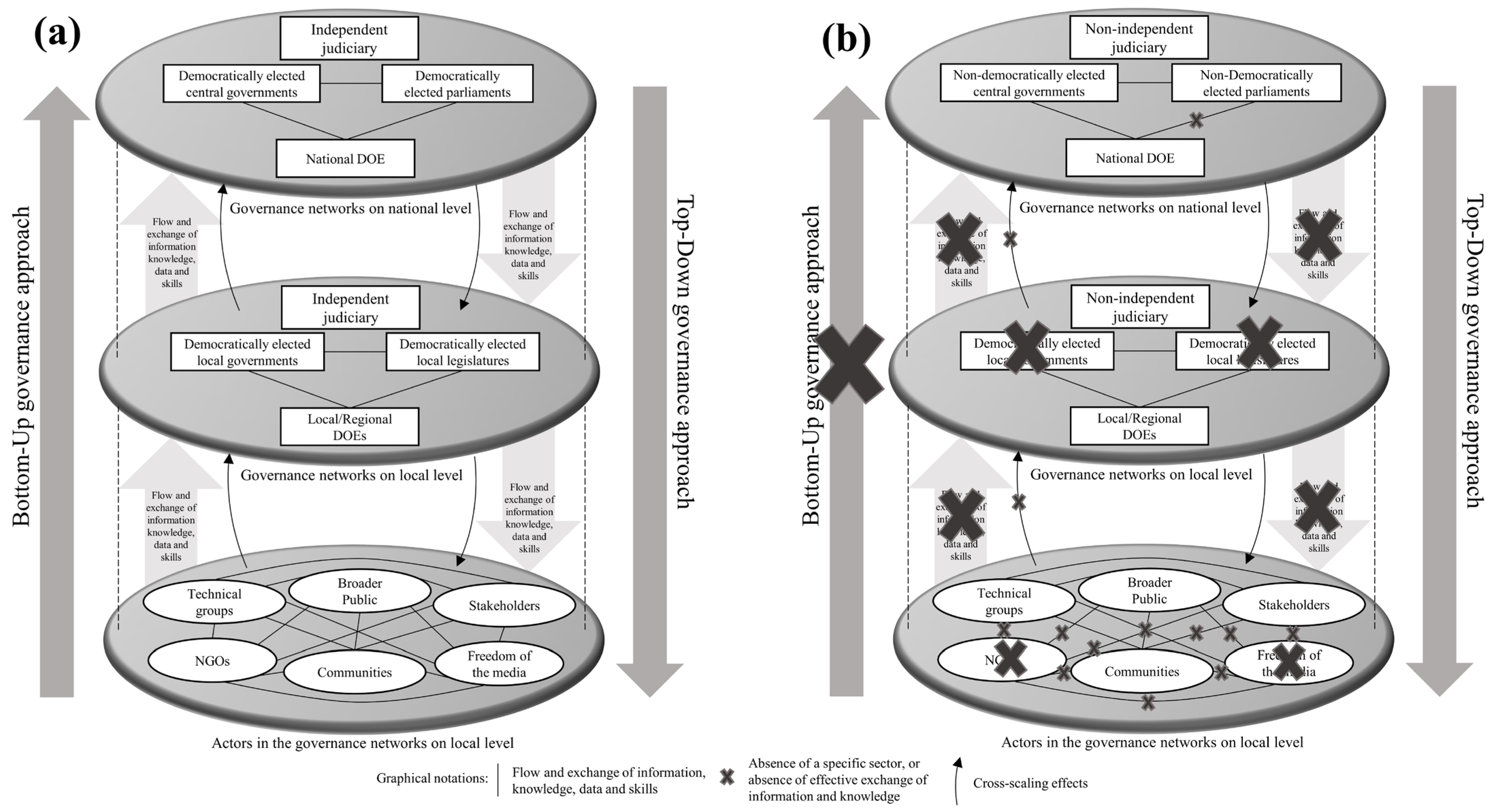
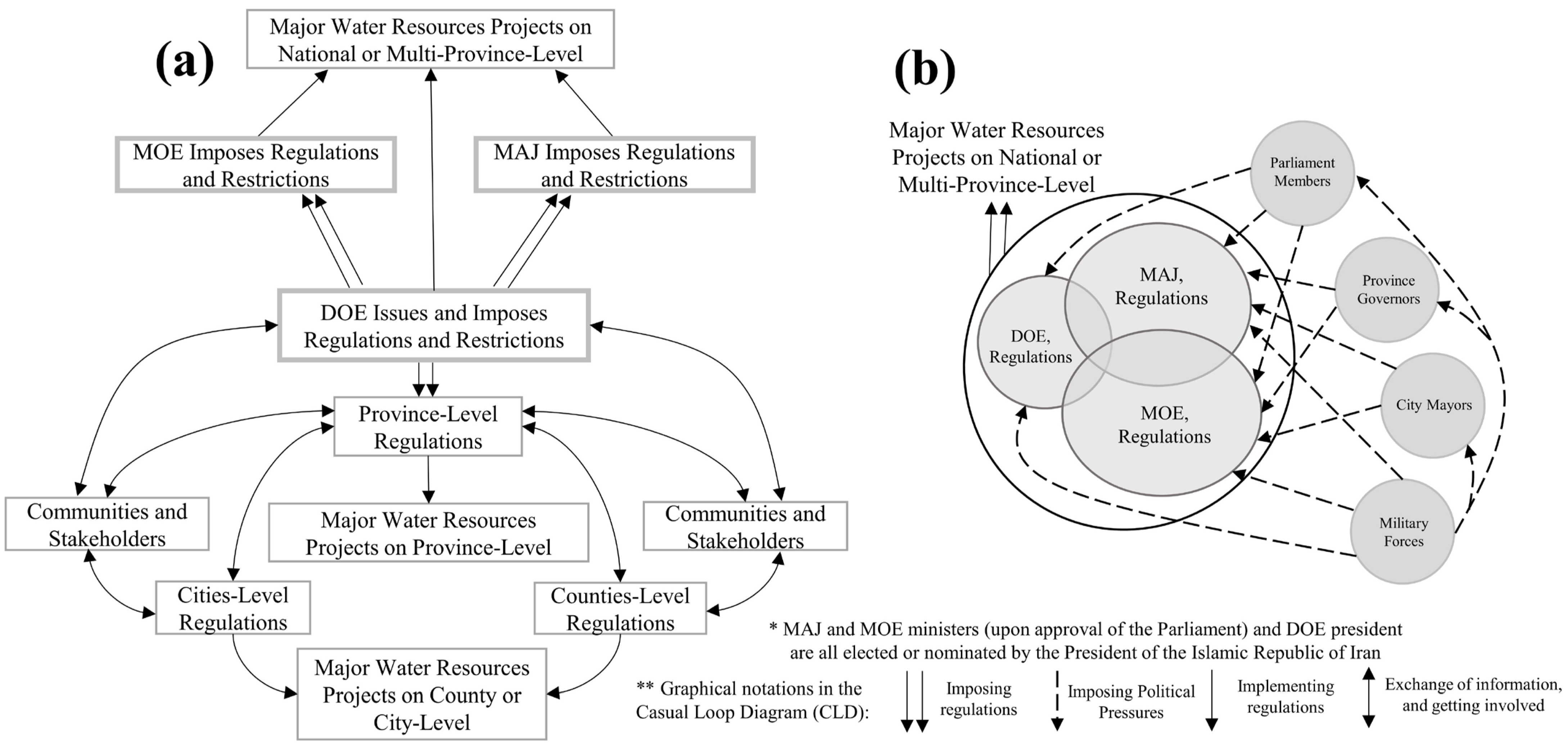
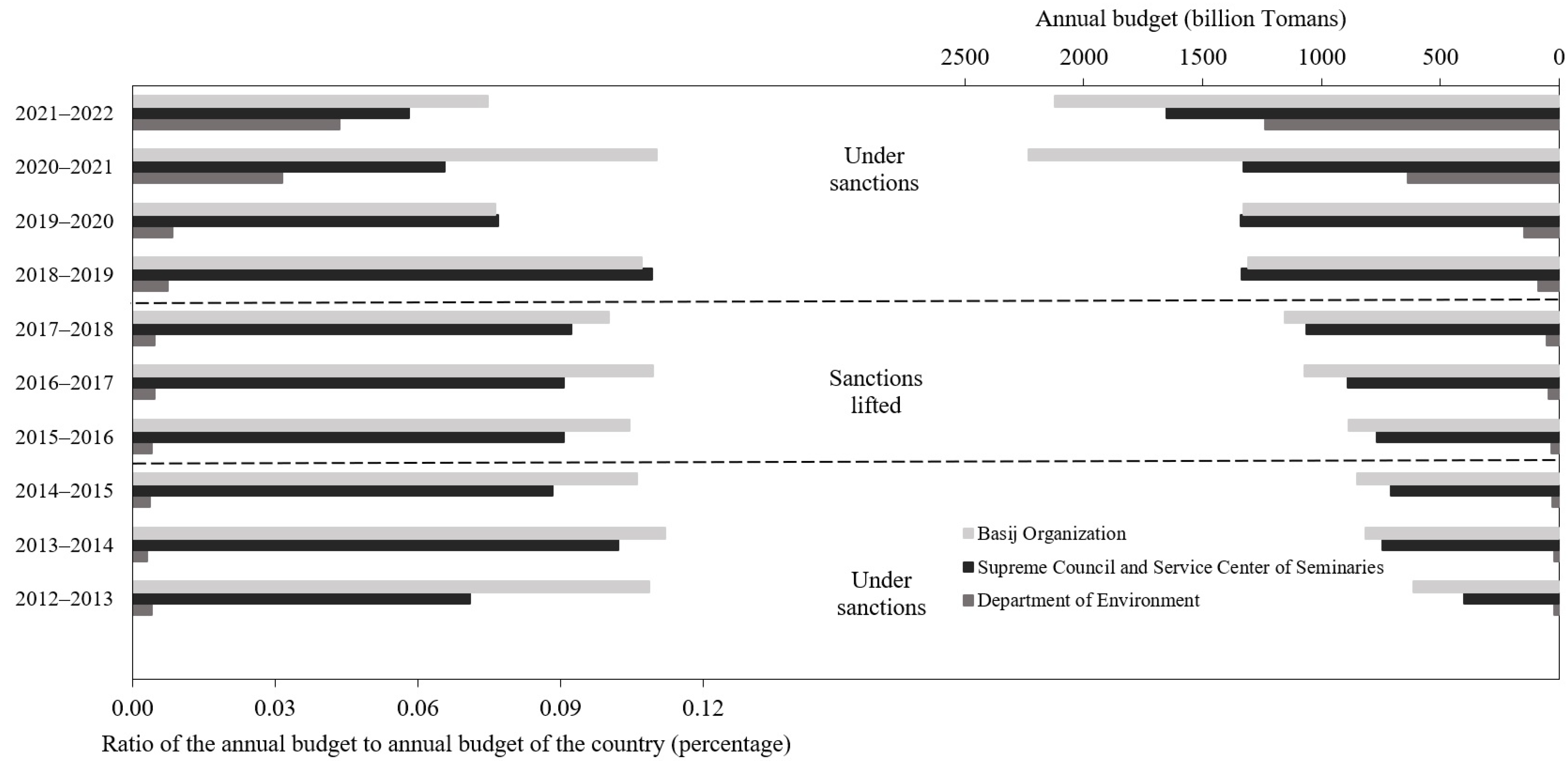

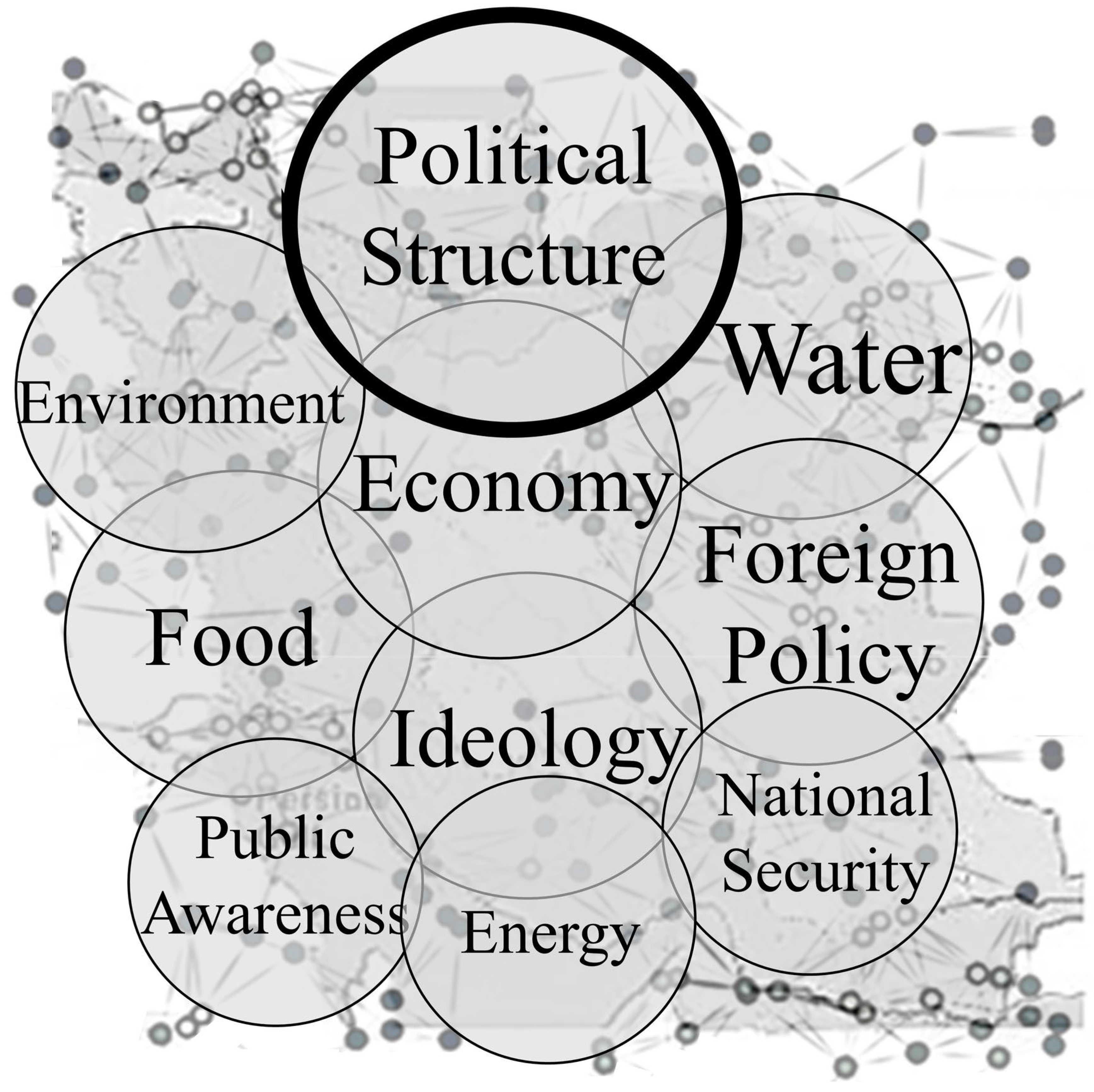
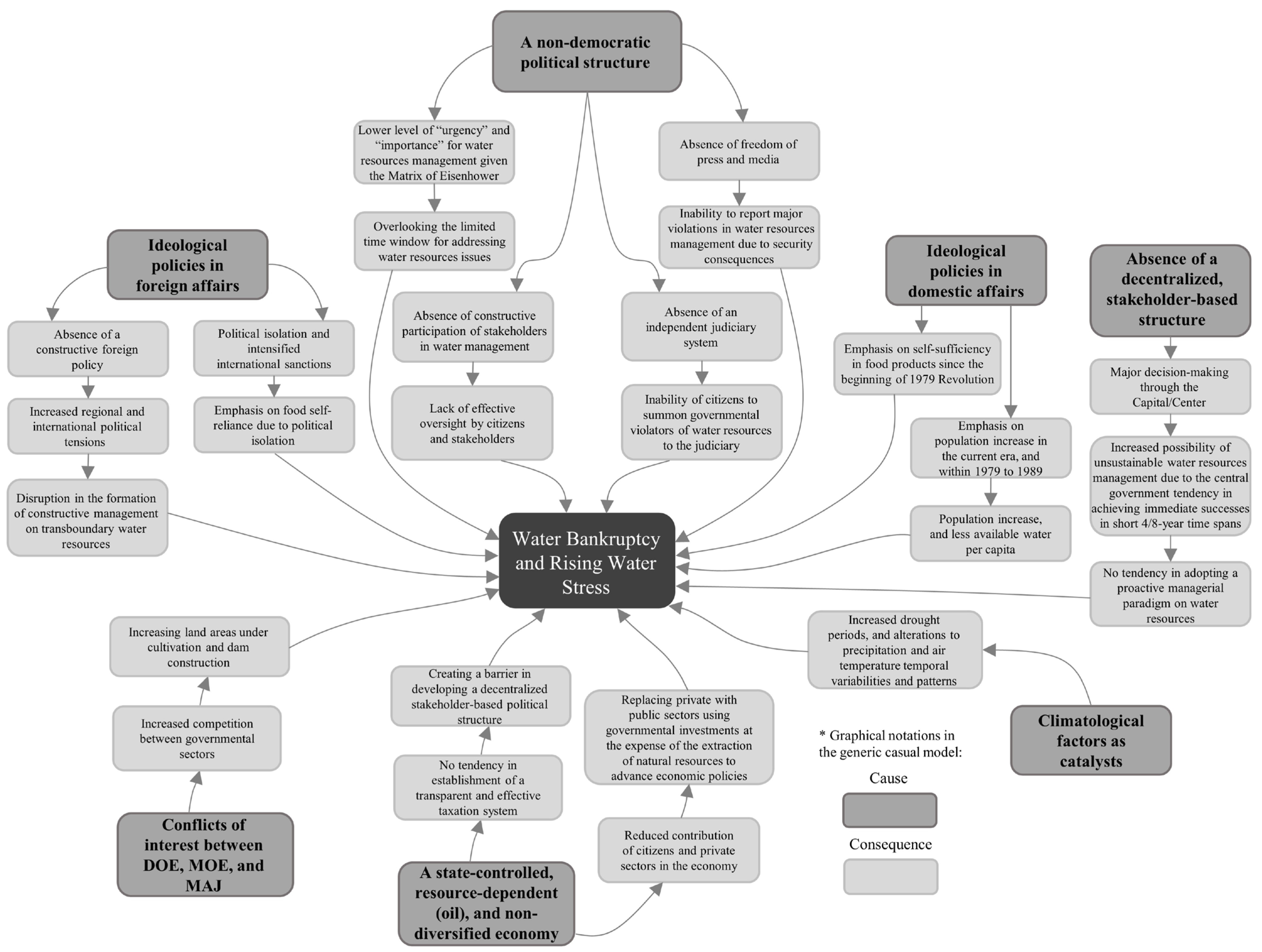
Publisher’s Note: MDPI stays neutral with regard to jurisdictional claims in published maps and institutional affiliations. |
© 2021 by the author. Licensee MDPI, Basel, Switzerland. This article is an open access article distributed under the terms and conditions of the Creative Commons Attribution (CC BY) license (https://creativecommons.org/licenses/by/4.0/).
Share and Cite
Ketabchy, M. Investigating the Impacts of the Political System Components in Iran on the Existing Water Bankruptcy. Sustainability 2021, 13, 13657. https://doi.org/10.3390/su132413657
Ketabchy M. Investigating the Impacts of the Political System Components in Iran on the Existing Water Bankruptcy. Sustainability. 2021; 13(24):13657. https://doi.org/10.3390/su132413657
Chicago/Turabian StyleKetabchy, Mehdi. 2021. "Investigating the Impacts of the Political System Components in Iran on the Existing Water Bankruptcy" Sustainability 13, no. 24: 13657. https://doi.org/10.3390/su132413657
APA StyleKetabchy, M. (2021). Investigating the Impacts of the Political System Components in Iran on the Existing Water Bankruptcy. Sustainability, 13(24), 13657. https://doi.org/10.3390/su132413657





